| French Motets in the Thirteenth Century�P |
| p15 ���e�b�g�̋N���Ə����̗��j �@Modern views of the motet see its history as an evolution from the clausula. The clausulae that were preserved in the �eNotre-Dame* sources had apparently been composed t�� enrich the Magnus liber organi, and then served as �es����r����s' for the motet. The generations who reworked the Magnus liber organi of Leoninus replaced the original clausulae with a large number of substitutes. The writing of substitute clausulae apparently generated even more possible sources. �@�ߑ�̃��e�b�g�ɂ��Ă̌����́A���j�I�ɁA���ꂪ�N���E�Y������̐i���ł���A�Ƃ��Ă���B�m�[�g���_���\�[�X�Ɏc����Ă���N���E�Y���́A���炩�ɁA�u Magnus liber organi�v��L���ɂ���悤�ɍ���Ă���A�����ă��e�b�g�̃\�[�X�Ƃ��Ă̖������͂����Ă����B���I�i���́u Magnus liber organi�v��������������́A���Ƃ��Ƃ̃N���E�Y���𑽐��́hsubstitute"�ւƒu���������B There are however problems with this view that concern the nature of the clausula itself. Several clausulae survive for the same passage in organa that can only be performed in the liturgy once a year. It might therefore be questioned whether substitution within the liturgy was their real purpose. There is at least the possibility that some of the �esubstitute' clausulae were in fact musical models to facilitate the performance of newly composed motets. Although the notation of motets in the earliest sources is problematic, the notation of the larger part of the clausula repertory is unequivocal. �����ɂ͂������A�N���E�Y�����g�̐����Ɋւ��錩���ւ̖��_�����݂���B�������̃N���E�Y���͔N1��̋V���Ŏg����I���K�k���ɂ����铯���ӏ��Ɏc���Ă���B����䂦�A�V�����hsubstitute"���͂����Đ^�̖ړI�ł��������ǂ����ɂ͋^�╄�������Ă���B���Ȃ��Ƃ��esubstitute'�N���E�Y���̂������́A���ہA�V�������ꂽ���e�b�g�̎�����e�Ղɂ��邽�߂̉��y���f���ł������\���͂���B�ŏ����̃\�[�X�ɂ����郂�e�b�g�̋L���@�ɂ͋^�₪���邪�A�N���E�Y�����p�[�g���[�̑啔���̋L���@�́A�͂�����Ƃ��Ă���B ����́A�N���E�Y���̃��[�h���Y������肷��A�����ɂȂ������L�������̃��Y����ǂނ��Ƃ��\�ɂ��邩��ł���B This is because the notes joined in ligatures that identify the modal rhythms of the clausula have to be separated when the motet text is added. The resulting motet notation lacks the combinations of ligatures that make it possible t�� read the rhythms.1 This plausible explanation for the multiplicity of clausulae may be difficult to prove, but it must be considered in any description of the conventional view of the progress of the motet. We need, then, to maintain a bifocal view of the clausula that acknowledges the possibility that It could be either �� straightforward source, or �� notational model, for the ����tet� �PSanders,�eMedieval Motet, 505�\7. �N���E�Y���̑��l���ɑ��邱�̑Ó��Ȑ����́A�ؖ��͍��������Ȃ����A���e�b�g�̐i���̏]���̌����̂����Ȃ�L�q�ɂ����Ă��l������Ȃ���Ȃ�Ȃ��B��������,���e�b�g�ɑ��āA���ړI�\�[�X�A���[�_���L���@�̂ǂ���ɂ����Ă����݂�����悤�ȉ\����F�߂���悤�ȃN���E�Y���ւ̂Q�œ_�I�Ȍ������ێ�����K�v������B �@Simply t�� compare �� motet with its �es����r����' clausula is to ignore many important relationships. These include the connections between the clausula, its host�@organum,the parent plainsong ���� the organum itself and the liturgical context of the plainsong. Some or all of these have far-reaching implications for the ways in which the motet develops. Any discussion of musical and textual procedures in the motet will make frequent reference to these backgrounds to musical composition and recomposition. �@�P���Ƀ\�[�X�N���E�Y�������e�b�g�Ɣ�r���邱�Ƃ́A�d�v�Ȋ֘A�����邱�ƂɂȂ�B�����̓N���E�Y������Ƃ��Ƃ̃I���K�k���A�I���K�k�����g�̂��ƂƂȂ����v���C���\���O�A�����ăv���C���\���O�̋V�����e�Ƃ̊֘A���܂�ł���B���������邢�͂���炷�ׂĂ��A���e�b�g�����W���������ɍL�͂ȉe����^���Ă���̂ł���B���e�b�g�ɂ����鉹�y��̎��쐬�̋c�_�́A�����̔w�i��p�ɂɎQ�Ƃ��ċȂ̍\���A�č\�����s�����Ƃ��낤�B �@In the earliest years of the thirteenth century, the retexting of clausulae was only one of a variety of procedures that resulted in the creation of the motet.2 A wide range of compositions arose out of differing attitudes to the combination of poetry and music. This is not, however, to overturn or even to challenge the veracity of the traditional view of the genesis of the motet, but is an attempt to supplement it. The view that motets were created out of the retexting of clausulae is supported by the large numbers of motets and clausulae that share the same music. Although this �egenetic'lelationship had, by the midd��� of the century, proved to be the way forward for composers, we should not be blind to the wide range of experimentation that characterised the emergence of the motet. �@13���I�̂����Ƃ������̍��A�N���E�Y���� retexting �́A���e�b�g�����Ɍ��т����ω��̉ߒ��̈�ł������B��Ȃ̕��L���͎��Ɖ��y�̑g�ݍ��킹�ւ̈قȂ����ԓx����N�����B�������A����̓��e�b�g�̋N���Ɋւ���`���I�Ȍ����̐^���������A���邢�͒��킷�邱�Ƃł͂Ȃ��B���e�b�g���N���E�Y���� retexting �ɂ���Đ��܂ꂽ�Ƃ��錩���́A�������y���Ƃ��ɂ��鑽���̃��e�b�g��N���E�Y���̑��݂ɂ���Ďx������Ă���B���������h�����h�W�́A13���I���܂łɁA��Ȏ҂ɑ���O�����̓��ł��邱�Ƃ��ؖ������B��X�́A���e�b�g�̏o��������Â��镝�L�������ɖӖڂł����Ă͂Ȃ�Ȃ��B 2�@The challenge to the conventional view of the priority of clausula over motet presented in Wolf�@F��������������s�C�eZum genetischen Verhaltnis zwischen Notre-Dame-Klauseln und ihren Motetten', is ill directed. Frobenius gi����s substantially insufficient weight to the question of the clausula's liturgical ������t��xt�C and (critically) is unaware of any of the problems surrounding the definition of refrains and the �������� they play in polyphony. 2 Wolf�@F��������������s�́eZum genetischen Verhaltnis zwischen Notre-Dame-Klauseln und ihren Motetten'�ɂ�郂�e�b�g�ɑ���N���E�Y����priority�ւ̓`���I�����ւ̒���́A����������ł���BFrobenius�́A�N��������̓T��I���e�ւ̋^��Ɋւ��ẮA�{���I�ɕs�\�����E�F�C�g�����u���Ă��Ȃ��B�����āArefrain�̒�`���߂�����₻��炪�|���t�H�j�[�ɂ����ĉ���������ɋC�Â��Ă��Ȃ��B ���e�b�g�ƃN���E�Y���\�]���I���� Poetry �@Despite the fact that the �etradit����������' relationship between motet and clausula has been acknowledged for ��ver �� century, fe�� attempts have been made to come to terms with the compositional dynamics of writing new texts to old music. An example will point to some of the ways these relationships may be considered. �@���e�b�g�ƃN���E�Y���̓`���I�ȊW�����I���ĔF�߂���Ƃ��������ɂ�������炸�A�V�����̎����Â����y�ɏ������ނƂ�����ȏ�̃_�C�i�~�N�X�Ɍ��y���鎎�݂͂قƂ�ǂȂ���Ă��Ȃ��B�����́A�����̊W���l���������@�̂��������w�������ł��낤�B The clausula embedded in the Pentecost organum, Alleluya. paraclitus spiritus sanctus(M26), served as the source for �� number of motets. The fact that it survives embedded in �� host organum makes it fairly certain that the clausula is �� genuine pre-existent source for the motet, and not simply �� newly composed model to aid its composition or performance. ����~�Փ��̃I���K�k��Alleluya. paraclitus spiritus sanctus(M26)�ɖ��ߍ��܂�Ă���N���E�Y���́A�����̃��e�b�g�Q�̃\�[�X�Ƃ��Ďg��ꂽ�B���̃N���E�Y�������Ƃ��Ƃ̂̃I���K�k���ɖ��ߍ��܂�Đ����c���Ă���Ƃ��������́A�N���E�Y�������e�b�g�ɑ��Ă��Ƃ��Ƒ��݂��Ă����^�̃\�[�X�ł���Ƃ������Ƃ����Ȃ�m���Ȃ��̂Ƃ��Ă���B�����āA��Ȃ≉�t�������邽�߂ɐV���ɍ��ꂽ���f���ł͂Ȃ��B The first thirty-three perfections of the clausula are given as Example 2.1. I�� many respects, this is �� good example of the ways in which a clausula functions, and ���� the material that would challenge the composer of the motet. Rhythmically, the organisation of the upper voice (the duplum) depends on the first rhythmic mode with a substantial degree of extensio modi. In transcription, this results in a mixture of two rhythmic patterns. One is based on dotted crotchets and the other on an alternation of crotchets and quavers. �N���E�Y���̍ŏ��̂R�Rperfection��Example 2.1�Ɏ�����Ă���B�����̓_�ɂ����āA����́A�N���E�Y�����@�\������@�ƁA���e�b�g�̍�Ȏ҂ɒ��킷��f�ނ̗ǂ���ł���B���Y���ɂ����āAduplum�̍\���́A�����I��extensio modi�̓x����������P���[�h�Ɉˑ����Ă���Btranscription�ɂ����ẮA����͂ӂ��̃��Y���p�^�[���̍����ƂȂ�B�Е��͕t�_�l�������A�Е��͎l�������Ɣ��������̌��ƂȂ�B 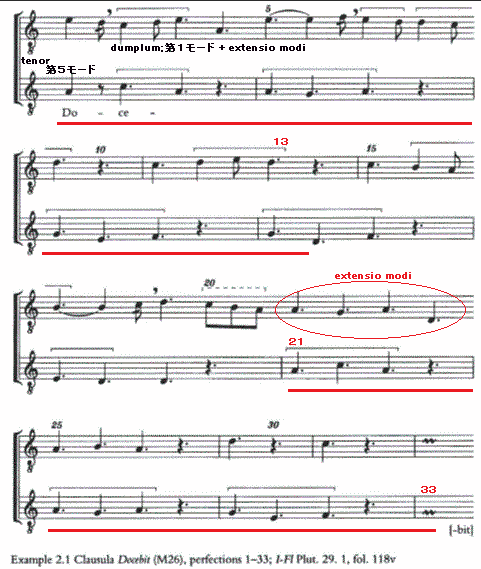 The use of two types of rhythm determines the changes in the declamation of the t����t of any motet subsequently based on this clausula. The tenor moves in the dotted crotchets of the fifth rhythmic mode. The contrapuntal style of the piece is unexceptional. Phrases generally begin and end on ��ha���@�iohannes de Garlandia called perfect concords (��nis���� and octave), imperfect concords (��ajor and minor thirds) and intermediate concords (fifth and fourth).3 ���̓�̃^�C�v�̃��Y���̗��p�́A���̃N���E�Y���Ɋ�Â��Ĉ��������č��ꂽ�������̃��e�b�g�̉̎���declamation�ɂ�����ω��ɉe����^���Ă���Btenor�͑�T���[�h�̃��Y���ŕt�_�l�������œ����Ă���B���̍�i�̑Έʖ@�I�����͗�O�I�ł͂Ȃ��B�t���[�Y�͈�ʓI�ɁA�iohannes de Garlandia�����S���a�����i���j�]���A�I�N�^�[�u�j�A�s���S���a�����i���Z�O�x�j�A�����Ē��ԋ��a�����i���S5�x�A4�x�j�ƌĂ����Ŏn�܂�A�I���B �@The overall structure of the clausula is determined by the patterning of the tenor.There are two statements of the tenor, ��r cursus and each is complete. This has the effect of dividing the piece into two sections. The first cursus begins the piece; the second begins at perfection 61. The rhythmic organisation of each is different.Groups of three longae and a longa rest structure the first cursus. Patterns of three tongae, longa rest, longa d�@&!�xf longa and a longa rest control the second. �@�N���E�Y���ɂ�����S�̍\���́Atenor�̃p�^�[���ɂČ��肳����Btenor���邢��cursus�̓�̉��^������A���ꂼ�ꂪ���S�ł���B����́A��i���ӂ���section�ɂ킯����ʂ�����B�ŏ���cursus�͍�i�̍ŏ�����A����cursus��perfecion61����n�܂��B���Y���\���͊e�X�ňقȂ�B�R��longa��longa rest�\���͍ŏ���cursus�Ō�����B Example 2.2 gives the plainsong on which the clausula is based and the two rhythmic patterns that organise it. There are differences in duration between the two cursus. In the first, six notes in the tenor occupy eight perfections; in the second, only five notes occupy the same musical space. Example 2.2�̓N���E�Y�������̃x�[�X�Ƃ����v���C�\���O�Ƃ�����\������Q�̃��Y���p�^�[���������Ă���B�Q��cursus�̒����ɂ����ĈႢ������BCursus�T�ɂ����ẮA�U�̉������Wperfection�����߂Ă���B�b�����������U�ɂ����ẮA�T�̉������������y��Ԃ��߂Ă���B 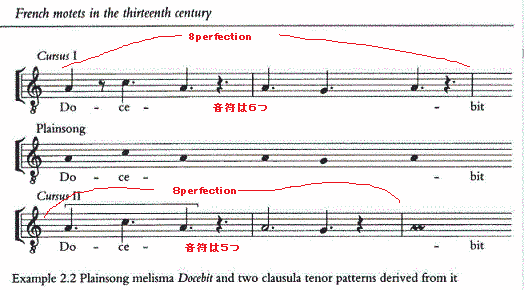 �@The duration of the piece is thus determined ��s follo��s: the first cursus lasts 60 (5�~12) perfections, the second �V�Q (6�~12). The two therefore stand in �� �T : 6 relationship. Within each cursus�C furthermore, the first ten pitches are repeated ��s pitches 16 to 25. They correspond t�� perfections 1-13 and�@21�|33 in the first cursus shown in Example 2.1. The composer reflects this repetition in the duplum. In the section before the repetition of the tenor pitches, the music proceeds according to simple Mode I patterns. At the point where the tenor repeats (perfection 21) the music moves into patterns using extensio modi. Phrases that consisted of crotchets and quavers are replaced by those made up of dotted crotchets. This, too, is visible in E��ample 2.1. In the second cursus however, the repetition of the tenor pitches seems to be ignored. It occurs in the middle of the first limb of the repetition of �� duplum phrase in which musical preoccupations lie elsewhere� �@��i�̒����͂���䂦�ɁA���̂悤�Ɍ��肳���B�ŏ���cursus ��60 (5�~12)perfection�B����cursus�͂V�Q (6�~12)perfection�B���҂͂��������āA�T�F�U�̔�ɂȂ�B���ꂼ���cursus�ɂ����Ă͂���ɁA�ŏ��̂P�O��pitch��pitch16����Q�T�ŌJ��Ԃ����B�����́Aexample2.1�ɂ������Pcursus�ɂ����ẮAperfections 1-13��21�|33�ɑ�������B��Ȏ҂�duplum�ɂ����Ă����̌J��Ԃ��f�����Ă���Btenor��pitch�̌J��Ԃ��O��section�ɂ����āA���y�͒P���ȑ�P���[�h�Ői��ł����Btenor��perfection21�ŌJ��Ԃ��Ƃ���ł́A���y��extensio modi. ���g���p�^�[���ɂȂ��Ă���B�S�������ƂW����������Ȃ�t���[�Y�́A�t�_�S�������Œu���������Ă���B������܂��Aexample2.�P�ɂĖ��炩�ł���B��Qcursus�ł͂������Ȃ���Atenor pitch�̌J��Ԃ��͖�������Ă���B����́A���y�I�S�����̏ꏊ�ɂ���duplum�̌J��Ԃ��̍ŏ��̎���|����̓r���ŋN����B 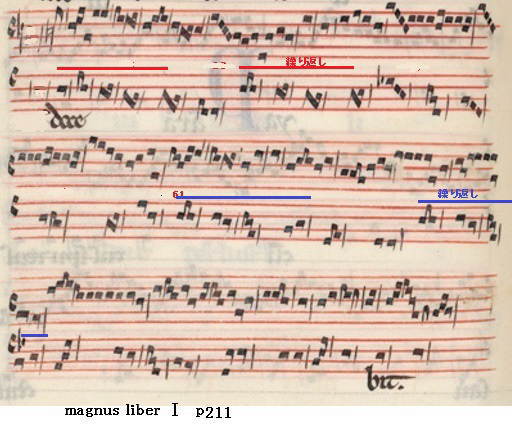 ����~�Փ��̃I���K�k��Alleluya. paraclitus spiritus sanctus(M26)��� �@There are examples of phrase repetition in the duplum above the tenor in each cursus. However, these do not coincide with the internal repetition of the tenor. The duplum repetitions therefore take place over different tenor notes. Both pairs of repetitions are given as Example 2.3.�P and Example 2.3�2. The repetition in the first cursus (Example 2.3.1) is marked out by the following rests or suspirationes in both parts. By contrast, the repetitions in the second cursu���@merge into the following phrases. The loosest form of melodic repetition occurs at the beginning of each of the two tenor cursus:�@�@the beginning of the clausula and ��t perfection 61. 1t is illustrated in Example 2.4. The duplum pitch a in the fourth perfection is absent in the repetition ��t perfection 64. Its absence may be prompted by aural considerations. The a is already present in the tenor in perfection 3�C and the duplum pitch is therefore almost a duplication. It is again present i�� the tenor in perfection 63; here, the duplum doubling is eliminated. There is also �� sense in which perfections 4�\8 recur in perfections 64�\9. The duplum phrase is shifted back a perfection to take account of the new distribution of the tenor pitches. These correspondences are made explicit in Example 2.4. The effect is nevertheless to alert the ear to the repetition of the tenor melody, even though the structure of the duplum phrase has been changed� �@���̂��̂�cursus�ɂ́Ateno�����duplum�ɂ����āA�t���[�Y�̌J��Ԃ��̗Ⴊ����B�������Ȃ���A������tenor�̓����̌J��Ԃ��Ƃ͈�v���Ȃ��Bduplum�̌J��Ԃ��͂���䂦�A�قȂ���tenor�̉������щz���ċN����B�J��Ԃ��̗��y�A�́A Example 2.3.�P�� Example 2.3�2�ɂ����ĔF�߂���BExample 2.3.1�ɂ���悤�ȑ�Pcursus�ɂ�����J��Ԃ��́A�����x���◼�p�[�g��suspirationes�ɂ���Ėڈ�����B�ΏƓI�ɁA��Qcursus�ɂ�����J��Ԃ��́A�����t���[�Y��ۂݍ��ނ��ƂɂȂ�B�����Ƃ����₩�ȃ����f�B�̌J��Ԃ��̌`���́A2��teno����cursus�̂��ꂼ��̎n�܂�ɂ���Ĉ����N�������B�N���E�Y���̍ŏ���perfection61�ɂ����Ăł���B�����Example 2.4�ɂ����Đ��������B��Sperfection�ɂ�����duplum�̉��������́Aperfection64�ɂ����Ă͌������Ă���B���̌����́A���o�I�l�@�ɂ���Ă킩��₷���Ȃ�B���̃����͂��ł�perfection3�̃e�m�[���ŏo�����Ă���A������duplum�̉����͂���䂦�ɁA�قƂ�ǃ_�u���Ă��܂��Ă���̂ł���Bperfection63��tenor�ɂ����Ă���͍Ăяo������Bduplum�̃_�u��͏�������Ă���Bperfection4-8�ɂ����ċN�����Ă��邱�Ƃ͂܂�perfection64-69�ɂ����Ă�����Ă���Bduplum�̃t���[�Y��tenor��pitch�̊���t�����l�����āA�Pperfection���Ƃɂ��炳��Ă���B���������Ή��́AExample 2.4.�ɂ����Ė����ł���B���̌��ʂ͌����āAtenor�����f�B�̌J��Ԃ��ɑ��ẮA�����悤�Ȃ��Ƃł͂Ȃ��B���Ƃ�duplum�̃t���[�Y�̍\�����ω��������悤�Ƃ��B 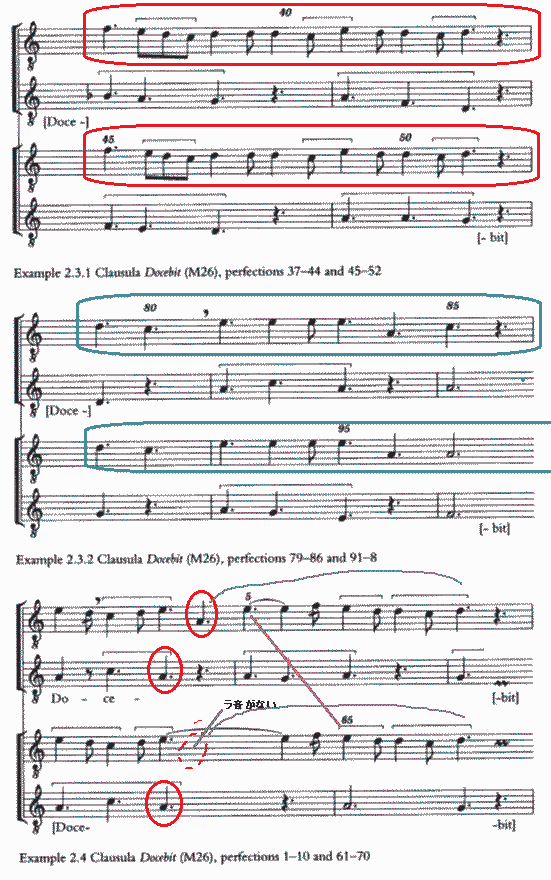 �@Against the unchanging patterns of the tenor ordines�C the duplum creates �� series of phrases of varying lengths. The interplay between the phrase-lengths of the two voice-parts is one of the most important points of interest in the piece. In general, the duplum phrases are constructed so as to overlap with those of the tenor. The fe�� points of coincidence, where the duplum ������ tenor do in fact pause together, are therefore of significance. In Example 2.3.1, we saw how simultaneous rests in both voices articulate the phrase repetitions in the first cursus of the piece. Particularly striking are the simultaneous phrase-endings in perfections 28 and 32� These are visible at the end of �d��ample 2. 1. The four-perfection phrase that separates the two cadences is curious. �@tenor�̕ς��Ȃ�����ɑ��Aduplum�͂��܂��܂Ȓ����̃t���[�Y�̘A��������Ă����B2���̃t���[�Y�̒����̊Ԃ̑��ݍ�p�́A���̍�i�ɂ����Ă����Ƃ������[���_�̈�ł���B��ʓI�ɁAduplum�̃t���[�Y��tenor�̂���ɏd�����č���Ă����B�����Ȃ���v�_�i�����͎�����Atenor��duplum���������ɋx�~������Ƃ���ł���j�́A����䂦�d��ł���BExample 2.3.1�ɂ���悤�ɁA��X�́A�����ɂ����铯���ɋN����x�����A�ǂ̂悤�ɂ��ăt���[�Y�̌J��Ԃ����Ȃ���̂����A���̍�i�̑�Pcursus�ɂ����Č����B���ɋ����[�����Ƃ́Aperfection28��32�ɂ�����A�Q�������ɋN����t���[�Y�̏I���ł���B4��perfectio���̃t���[�Y���A�ӂ��̃J�f���c�����邱�Ƃ͋����[���B This is in fact the exact centre of the first cursus of the piece, and is marked by �� central four-perfection phrase ���� which the duplum is divided into two two-perfection phrases. Although the duplum employs other two perfection phrases in the clausula (perfections 71 and 125, fo�� example) this is the only occasion where two such phrases are juxtaposed� ����͎��ۂ́A��i�̑�Pcursus�̐��m�Ȓ��S�ł���Aduplum���Q�̂Qperfection�t���[�Y�ɕ������钆�S�̂S��perfection�t���[�Y�ɂ���ă}�[�N����邱�Ƃł���Bduplum�̓N���E�Y���ɂ����ĕʂ�2��perfection�t���[�Y�������Ă���(perfections 71 and 125, fo�� example)����ǂ��A����͂��������t���[�Y���ڂ��Ă���B��̏ꏊ�Ȃ̂ł���B�@ �@Questions of number and symmetry should play an important role in structuring a work without �� text. The only literary component to the clausula is the residue of the plainsong melisma Docebit, and this seems to have little effect on the work. As the clausula is turned into �� motet by the addition of words, these numerical and symmetrical patterns may be retained, exaggerated ��r contradicted� �@���ƑΏ̐��̖��́A�̎��̂Ȃ���i�̍\���ɂ����āA�d�v�Ȗ����������Ă���B�N���E�Y���ɑ���B��̕����\�������́A�v���C���\���O�̃����X�}�ł���Docebit�̎c�蕔���ł���B����͍�i�ɂ͂قƂ�lje���������Ȃ��B�N���E�Y���͌��t���̃��e�b�g�֓]������A�����������ƑΏ̐��\���͕ێ�����A�֑剻����A�������g�傷��B �@The general principles for the creation of �� text to �� pre-existent clausula consist of adding a poetic text to the duplum. In writing poetry to fit the music of the clausula, the composer adheres very strictly to the rhythmic patterns of the upper voice of the clausula, and adds one poetic syllable to each note. Even where the surreptitious addition or subtraction of a ����te might have made the work more easy, the composer in general faithfully preserved the pattern of his original material.4 �@�������݂��Ă����N���E�Y���ɑ���̎��t���̈�ʓI�����́Aduplum�ɑ��ĉ̎������邱�Ƃɂ���B�N���E�Y���̉��y�ɓK���鎍�������ɂ�����A��Ȏ҂́A�N���E�Y���̏㐺���̃��Y���p�^�[���Ɍ����ɏ]���K�v������B�����āA�ЂƂ̉��ɂ͂ЂƂ̃V���u�������邱�ƂɂȂ�B�����̑�����������������Ƃ��ȒP�ɂł���ꏊ�ɂ����ẮA��Ȏ҂͈�ʓI�ɁA�����ɁA�I���W�i���ȑf�ނ̃p�^�[����ۑ����Ă����̂ł���B �@Example 2.5 shows the first thirty-three perfections of the motet (344) Doceas hac die-Docebit (M26) that results from the addition of �� poetic text to the clausula: �` comparison of the motet with the clausula given in Example 2.1 shows how, in general, one note in the clausula corresponds to one syllable of text in the poem, and how there is only minimal alteration of ��rn��������t��tion and ali����������t of notes.6 �@Example 2.5�́A�O�o�̃N���E�Y���ɑ��Ď���������ꂽ���e�b�gDoceas hac die-Docebit �̍ŏ��̂R�Rperfection�������Ă���BExample 2.1�Ŏ����ꂽ�N���E�Y���ƃ��e�b�g�Ƃ̔�r�́A��ʓI�ɁA�N���E�Y���ɂ�����ЂƂ̉����ǂ̒��x���̒��̂ЂƂ̉��߂ɑ������邩�A�����āA���̑����⊄�蓖�Ăɂ����Ăǂ̒��x�ŏ��̕ω�������̂��������Ă���B Line-lengths in the poem are controlled by phrase-length in the clausula. The composition of the poem is not affected by the alt��rnations of rhythmic mode. The music to which the lines �eTerminus vie / Ihesu pie' etc. are set has ���� effect on the length of the lines of poetry. It will be remembered that, in the clausula, this change of rhythmic mode in the duplum mirrored the repetition of pitches of the tenor. The addition of �� motetus poem that fails t�� respond t�� this feature of the clausula has the effect of smoothing over this structural gesture. The dynamics of the new motet poem override those of the old clausula� ���ɂ�����s�̒����́A�N���E�Y�����̃t���[�Y�̒����ɂ���ăR���g���[������Ă���B���ɑ����Ȃ̓��Y�����[�h�̌��ɂ���ĉe������邱�Ƃ͂Ȃ��BTerminus vie / Ihesu pie'���̍s�����鉹�y�́A���̍s�̒����ɂ͉���e�����Ȃ��B�N���E�Y���ɂ����ẮAduplum�ɂ����郊�Y�����[�h�̂��̕ω��́A�e�m�[���̉��̌J��Ԃ��ɑ���͕�ɂȂ��Ă��邱�Ƃ͗������Ă����ׂ��ł���B�N���E�Y���̂������������ɔ����������˂�motetus�̎��ւ̕t���́A�\���I�ȐU�镑�����Ă���R�ɂ�����ʂ��������B�V�������e�b�g�̎��̃_�C�i�~�N�X�́A�Â��N���E�Y���̂�������z�����̂ł���B �@�@�@�@�@�@�@�@�@�@�@�@�@�@�@�@�@�@�@�@�@Doceas hac die �@�@�@�@�@�@�@�@�@�@�@�@�@�@�@�@�@�@�@�@�@Viam patrie, �@�@�@�@�@�@�@�@�@�@�@�@�@�@�@�@�@�@�@�@�@Fons gratie�B�@�@�@�@�@�@�@�@�@�@�@�@�@�@ �@�@�@�@�@�@�@�@�@�@�@�@�@�@�@�@�@�@�@�@�@Spes venie, �@�@�@�@�@�@�@�@�@�@�@�@�@�@�@�@�@�@�@�@�@Terminus vie, �@�@�@�@�@�@�@�@�@�@�@�@�@�@�@�@�@�@�@�@�@Ihesu pie. �@�@�@�@�@�@�@�@�@�@�@�@�@�@�@�@�@�@�@�@�@Me de sortis vane �@�@�@�@�@�@�@�@�@�@�@�@�@�@�@�@�@�@�@�@�@Solvas et humane �@�@�@�@�@�@�@�@�@�@�@�@�@�@�@�@�@�@�@�@�@Camis carcere. �@�@�@�@�@�@�@�@�@�@�@�@�@�@�@�@�@�@�@�@�@Rege, �@�@�@�@�@�@�@�@�@�@�@�@�@�@�@�@�@�@�@�@�@Quem sublege �@�@�@�@�@�@�@�@�@�@�@�@�@�@�@�@�@�@�@�@�@lubes degere. �@�@�@�@�@�@�@�@�@�@�@�@�@�@�@�@�@�@�@�@�@Sine luce �@�@�@�@�@�@�@�@�@�@�@�@�@�@�@�@�@�@�@�@�@Tua duce �@�@�@�@�@�@�@�@�@�@�@�@�@�@�@�@�@�@�@�@�@Nichi! prospere �@�@�@�@�@�@�@�@�@�@�@�@�@�@�@�@�@�@�@�@�@Possum agere. �@�@�@�@�@�@�@�@�@�@�@�@�@�@�@�@�@�@�@�@�@Vite �@�@�@�@�@�@�@�@�@�@�@�@�@�@�@�@�@�@�@�@�@Des �@�@�@�@�@�@�@�@�@�@�@�@�@�@�@�@�@�@�@�@�@Fructum de te vite; �@�@�@�@�@�@�@�@�@�@�@�@�@�@�@�@�@�@�@�@�@Elicere, �@�@�@�@�@�@�@�@�@�@�@�@�@�@�@�@�@�@�@�@�@Fecunde �@�@�@�@�@�@�@�@�@�@�@�@�@�@�@�@�@�@�@�@�@Gratiam funde, �@�@�@�@�@�@�@�@�@�@�@�@�@�@�@�@�@�@�@�@�@Cuius habunde �@�@�@�@�@�@�@�@�@�@�@�@�@�@�@�@�@�@�@�@�@Effluant unde, �@�@�@�@�@�@�@�@�@�@�@�@�@�@�@�@�@�@�@�@�@Unde �@�@�@�@�@�@�@�@�@�@�@�@�@�@�@�@�@�@�@�@�@Sint anime �@�@�@�@�@�@�@�@�@�@�@�@�@�@�@�@�@�@�@�@�@Fide munde, �@�@�@�@�@�@�@�@�@�@�@�@�@�@�@�@�@�@�@�@�@Spe iocunde. �@�@�@�@�@�@�@�@�@�@�@�@�@�@�@�@�@�@�@�@�@�c�� grade rore �@�@�@�@�@�@�@�@�@�@�@�@�@�@�@�@�@�@�@�@�@Sancti spintus amore �@�@�@�@�@�@�@�@�@�@�@�@�@�@�@�@�@�@�@�@�@Proficere, �@�@�@�@�@�@�@�@�@�@�@�@�@�@�@�@�@�@�@�@�@Me �@�@�@�@�@�@�@�@�@�@�@�@�@�@�@�@�@�@�@�@�@Qui docebit� 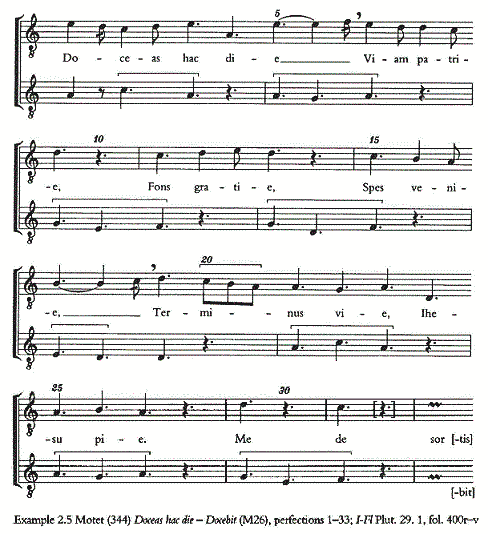 6�@Some differences between motet and clausula may arise from t����tual disturbance. Despite the fact that clausula ������ motet were composed at different times, they were both copied more or less simultaneously into the Florence manuscript. There are problems presented by trying to understand a history of this music when different historical layers are preserved in �� single source copied at �� single point in time. In the case in question, it is far from clear ���Ԃ���tly how much time separated the composition of the clausula from the texting of the motet. ���e�b�g�ƃN���E�Y���̊Ԃ̂������̑���́A�e�L�X�g�̍����ɂ����̂�������Ȃ��B�N���E�Y���ƃ��e�b�g���قȂ�������ɍ��ꂽ�ɂ�������炸�A���҂͓�����F�ʖ{�ɑg�ݓ����ꂽ�B���̉��y�̗��j�𗝉����悤�Ǝ��݂Ȃ��瑶�݂��Ă�����肪����B����́A�قȂ�������̊e�w�͂��A����̈�_�Ŏʂ��ꂽ�ЂƂ̃\�[�X�ɕۑ������悤�ɂȂ����̂��B�Ƃ������Ƃł���B���̃P�[�X�ɂ����āA���e�b�g�ւƉ̎��Â����ꂽ������N���E�Y���̍쐬���܂łǂ̂��炢�̔N�������������̂��́A�肩�ł͂Ȃ��B �@The treatment of rhyme ���� the poem is less dependent on the structure ���� the clausula. In fact, it seems as if the composer here is setting out to construct �� set of rhyme patterns that interweave with, but do not correspond to, the phrases of the duplum, now motetus, and the s����tax of the poem itself. �@���̎��ɂ�����C�̈����́A�N���E�Y���̍\���ɂ����ẮA���Ɨ������`�ƂȂ��Ă���B�����A�܂�ł����ō�Ȏ҂��Aduplum�i���݂�motetus)�̃t���[�Y��D����������Ď��̍\�����g�ƂȂ��Ă����C�̃p�^�[�������グ�Ă��邩�̂悤�Ɍ�����̂ł���B The poem is governed by �� single rhyme: -e. But there are groups of double rhymes throughout the poem. The first six lines all rhyme -ie and lines 21-5 all rhyme ��unde for example. In principle, these double rhymes are grouped so that when one double rhyme ends and is replaced by another, it does not recur. The result is �� sequence of double rhymes:-ie,-ane,-uce,-ite,-unde,and -ore. This sequence is contrasted with the recurrence of lines that rhyme -ere at various points in the poem (lines 9�C 12�C 15�C 16, 20 and 31).�@ ���͒P��̉C-e�Ŏx�z����Ă���B�������A����ʂ��āA��d�C�̃O���[�v������B�ŏ���6�s�͂��ׂ�-ie�̉C�ł���A�Q�P�`�Q�T�s�͂��ׂ�-unde�ł���B��{�I�ɂ����̓�d�C�́A��̓�d�C���I����ĕʂ̉C�ƒu��������ꂽ�Ƃ��ɍČ�����Ȃ��悤�ɕʃO���[�v�ƂȂ��Ă���B���̌��ʁA-ie,-ane,-uce,-ite,-unde, -ore�Ƃ����悤�ȓ�d�C�̘A���ƂȂ�B���������A���͍s�̍Č����ɑΔ䂳���B���܂��܂ȓ_�ɂ����āA-ere�Ɖ��C�����B However one choses to handle the detail of the analysis of the rhyme, It is clear that blocks of double rhyme articulate sections of the poem. The change of rhyme sometimes corresponds to musical phrase and/or to the sense of the poem. Often it does not. ���� combination with these two other methods of organising words and notes, it creates three layers of structural activity: rhyme, phrase and poetic ������t����t� �������Ȃ���A�C�̕��͂̏ڍׂ���舵���A��d���C���̂����܂肪���̃Z�N�V�������`�����邱�Ƃ����炩�ƂȂ�B�C�̂��̕ω��́A�Ƃ��ɂ́A���y�t���[�Y�⎍�̊��o�ɂ���������B�����A�ł͂Ȃ����B�����������t�Ɖ����̍\���ɂ��Ă̑��̓�̕��@�����т��A�C�A�t���[�Y�A�����e�Ƃ����悤���\���I�s���͂̂R�w�����������B �@The melodic repetitions in the clausul�� change as the poetic text is composed to fit the pre-existing music. ln the first cursus of the piece, the two limbs of the duplum repetition (Example 2.3.1)������ separated, in the motet, by the end of �� sense-group in the poem �| �eMe de sortis vane solvas et humane carnis carcere' �| and the beginning of another �| �eRege, quem sub lege iubes degere'. �@�N���E�Y���ɂ����郁���f�B�̌J��Ԃ��́A�̎��������̉��y�ɓK������悤�ɍ�Ȃ��ꂽ�Ɠ��l�ɁA�ω����Ă���B��i�̑�Pcursus�ɂ����āAduplum�̌J��Ԃ��̂ӂ���limb(Example 2.3.1)����������Ă���B���e�b�g�ɂ����ẮA����sense-group �̍Ō��eMe de sortis vane solvas et humane carnis carcere' �| �����Ď��̃O���[�v�̍ŏ� �| �eRege, quem sub lege iubes degere'. �ɊY������B But this self-contained textual phrase begins before the first limb. The text associated with the second limb continues after the end of the melodic repetition. In fact�C apart fr���� the obvious constraints on the composition ���� the poem dictated by the distribution of notes, there is little attempt t�� respond to these sorts of melodic subtleties. The original melodic repetition in the�@s���������� cursus of the piece is camouflaged even more effectively by rewriting part of the motetus. Example 2.6 superimposes the passage in the motet on that in the clausula. �������A���̎��Ȋ����^�̃e�L�X�g�t���[�Y�́A�ŏ���limb�̑O����͂��܂��Ă���B���ہA���̊���t���ɂ���ĂȂ��ꂽ���̍\���ւ̖��炩�Ȑ���͕ʂƂ��āA�����f�B�̔����ȗv�f�ɑΉ����悤�Ƃ������݂́A�قƂ�ǂȂ��B��i�̑�Qcursus�ɂ�����I���W�i�������f�B�̌J��Ԃ��́A���炽��motetus�̍ď������݂ɂ���āA�J���t���[�W������Ă���BExample 2.6�̓N���E�Y�����p�b�Z�[�W�ւ̃��e�b�g�̃p�b�Z�[�W���d�Ă���B �@ 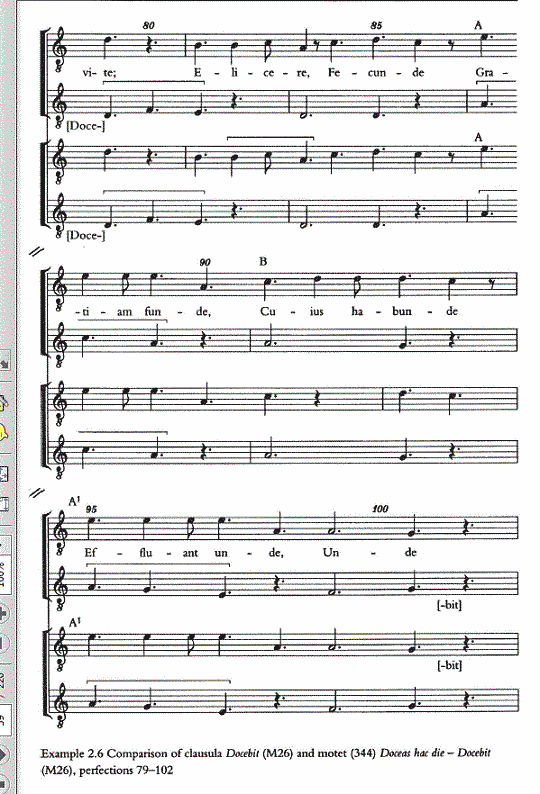 �@The two-perfection phrase (93�\4) clearly posed problems. In the normal course of events it would have required �� two-syllable line. One might have expected the line �eGratiam funde�f t�� have been extended by �� single syllable. But the poem at this point has just initiated �� sustained passage based on the double rhyme -unde. Choices of vocabulary ��r�� narrow here, and the word �e��������' was to be saved for the end of the phrase. It seems that the choice here was either to modify the rhyme-scheme or to change the melodic superstructure. The composer seems t�� have valued the continuity of rhyme in the poem more highly than the integrity of the melodic repetition in the clausula. Although the original melodic parallelisms of the clausula are lost by this process, the motet replaces the simple A-A�P repetition of the clausula with an A-B-A1 structure. This is marked in Example 2.6� �@�Q��perfection(93-94)�����炩�ɖ��ƂȂ��Ă���B�ʏ�ł���A���̕����͂Q�̉��߂�v������Ƃ���ł���BGratiam funde�̍s��1���ߕ������L����邱�Ƃ����҂����B�������A���͂��̓_�ɂ����āA��d�C-unde���x�[�X�Ƃ����ێ����ꂽ�p�b�Z�[�W���J�n����B�����ɂ������b�̑I���͌����Ă���B�����āA'unde'�̌�́A�t���[�Y�̍Ō�̂��߂Ɏc����Ă���B���̎��_�ł̑I���́A�C�̌v���ς��邩�A�����f�B�̏㕔�\����ς��邩�̂ǂ��炩�����Ȃ��Ǝv����B��Ȏ҂́A�����f�B�̌J��Ԃ��̊��S�������A���ɂ�����C�̌p�����ɂ�荂�����l��u�����悤�ł���B�N���E�Y���̃I���W�i���ȃ����f�B�̕��s��`�͂��̉ߒ��ł͎����Ă��܂�������ǂ��A���e�b�g�́A�N���E�Y�����P����A-A�P���J��Ԃ����AA-B-A1�\���ɒu���������̂ł���B �@�s�� summarise, we may agree that in general the process of texting respects the musical s������ace ���� the melismatic original, but ignores certain purely musical repetitions and numerical structures. The patterns of line-length in the poem very clearly reflect the lengths of phrases in the clausula. Rhymes, however, behave differently, and set up their own patterns over and above those created by the clausula. Where there are collisions between musical elements in the clausula and poetic elements in the newly composed text, the strictly musical concerns of the clausula yield to the musico-poetic dynamic of the motet� �@�܂Ƃ߁B�����͈�ʓI�ɁA�̎��Â��̉ߒ��ł́A���Ƃ��Ƃ̓����X�}�ł��������y��̏�ӂ͑��d���邪�������A�����ȉ��y�I�ȌJ��Ԃ��␔�\���͖�������B���ɂ�����s���̃p�^�[���͔��ɂ͂�����ƃN���E�Y���ɂ�����t���[�Y�̒����ɔ��f�����B�C�͂������Ȃ��炻�̐U�镑�����قȂ�A�N���E�Y���ɂ���č쐬���ꂽ�p�^�[���̏�ɓƎ��̃p�^�[����ݒ肵�Ă���B�N���E�Y�����̉��y�v�f�Ƃ��炽�ɍ��ꂽ�e�L�X�g�ɂ����鎍�̗v�f�̊Ԃ̂Ԃ��肪�ǂ��Ŕ������悤���A�N���E�Y���ւ̌����ȉ��y�I�S�́A���e�b�g�ɂ����鉹�y�Ǝ��̃_�C�i�~�b�N�ނ̂ł���B ���N���E�Y�����烂�e�b�g�ւ̖��_�Ɠ]�����̂��܂��܂ȍH�v�� �@The same processes are used i�� the creation of three-part motets from three-part clausulae. We may begin with questions of retexting, by comparing a three-part clausula and a so-called conductus-motet. The latter requires a little introduction. It received its name fr���� Ludwig, who pointed to the fact that the two upper voices were homorhythmic and carried the same text. Sometimes, the upper two voices alone were copied, in score, in the manuscripts. The resulting piece looked like �� conductus. The conductus-motet was therefore marked out from the �eclassic' three-part motet, in which the two upper parts carried differ����t texts and were rhythmically differentiated.7 7�@An alternative to this terminological conundrum has recently been ��r������sed by Darwin Scott: the �emonotextual' motet (Darwin F. Scott,�eThe Three- and Four-Voice �m�S�O����t����t������ Motets of the �m��tr���|Dame School* (Ph.D. diss., University of California at Los Angeles, 1988)).Altho��gh the term has much to recommend it, the sheer weight of the literature that uses the term �econductus-motet' forces its ��se in the present context. �@�������Ƃ��A3���N���E�Y������3�����e�b�g�̍쐬�ɂ����Ă�������̂ł���B��X��3���̃N���E�Y����conductus-motet�Ƃ̔�r�ɂ���āAretexting�̖��ɂ��čl���Ă݂����B��ҁiconductus-motet�j�͏����Љ�K�v�ł��낤�B���̖��O��,�ӂ��̏㐺�������ꃊ�Y���ł���A�����̎��������̎������w������Ludwig(�̒���j���痈�Ă���B�����A��̂Q�����̓X�R�A�`���Ŏʖ{���Ɏʕ�����Ă���B���̌��ʁA��i��conductus�̂悤�Ɍ����邱�ƂɂȂ�Bconductus-motet �͂���䂦��,�قȂ����̎��������A���Y���I�ɂ��قȂ��Ă����Q�̏㐺���p�[�g�������Ă���h�ÓT�I�h�R�����e�b�g�Ƃ͋�ʂ����B 7�@���̐��p��̑��肪�ŋ߁ADarwin Scott�������Ă���B���ꂪ�emonotextual' motet�̊T�O�ł���B���̗p��g�p�͑E�߂��邪�A �econductus-motet' �Ƃ����p����g�������ʂ�d�傳�́A����܂łƕς�邱�Ƃ͂Ȃ����낤�B �@The upper voices �����@�� conductus-motet are rhythmically homogeneous. In �� three-part clausura there ma�� be great rhythmic variety between the upper voices. Creating t���� motet from the clausula may therefore �������� to technical problems. Surmounting these diffculties is the larger part of the composer's achievement. Example 2.7 displays the first forty perfections of �� three-part clausula Latus (M14) with the motet derived from it [(229) Radix venie�\ (229) Radix venie -Latus (Ml4). �@conductus-motet�̏㐺���̓��Y���I�ɋψ�ł���B�R���̃N���E�Y���ɂ����ẮA�㐺���Ԃő����̃��Y���̃��@���G�e�B�����݂���B�N���E�Y�����烂�e�b�g����邱�Ƃ͂���䂦�A�Z�p�I���������N�����B��������������������邱�Ƃ́A��Ȏ҂����ɉۂ���ꂽ�傫�ȉۑ�ł���B Example 2.7�͂R���N���E�Y��Latus (M14)�Ƃ�������R���������e�b�gRadix venie�\ (229) Radix venie -Latus �������B 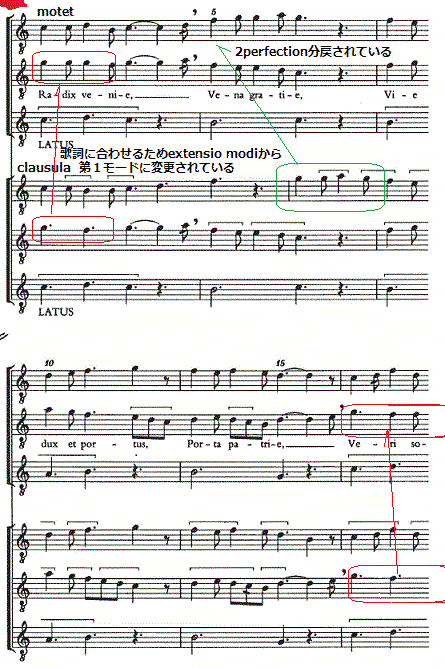  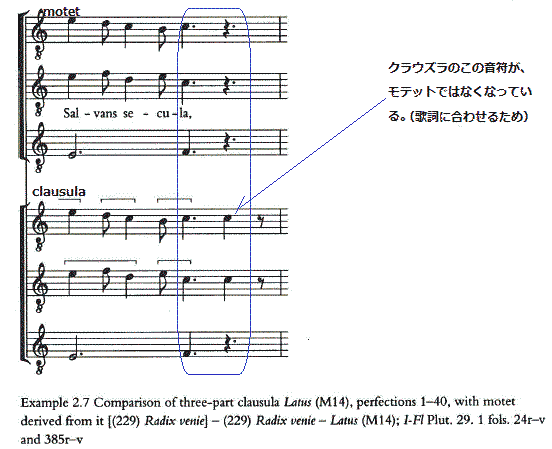 �@The composer texts both upper voices of the clausula with the same poem. Any musical complexities in the clausula that stand in the way of this task are likely to be subject to adjustment. We can see here a more extreme example of die subordination of musical sophistication t�� poetic exigency that we saw �� embryo �� the previous ��������p����� �@��Ȏ҂͓������ł����āA�N���E�Y���̗��㐺�����̎��Â����Ă���B����̉ۑ�̘�ɂ���N���E�Y���ɂ����鉽�������̉��y�I�ȕ��G���́A�����̑ΏۂƂȂ邩������Ȃ��B�����͂��̗�ɁA���̗D��̂��߂̉��y�I�����̏]�����̋ɒ[�ȗ�����邱�Ƃ��ł���B There is �� variety of different rhythmic patterns, each with different numbers of notes, in the triplum and duplum of the clausula. Perfections l�|3 and 17-20 ar�� two clear examples of this. ln the clausula, the Mode �� triplum presents fo��r and eight notes respectively. The duplurn, which mixes Mode �� with extensio modi, has two and four notes for the same passages. It is clearly impossible to underlay the same text to this music as it stands. The composer responds by dividing each of the dotted crotchets of the passage in extensio modi into simple Mode I patterns. This results in alternations of crotchets and quavers on the same pitch. �����ɂ͈قȂ������Y���p�^�[���̑��l��������B���ꂼ��́A�N���E�Y����triplum��duplum�ɂ����ĉ����̐����قȂ��Ă���BPerfections l�|3�� 17-20�͂���̂͂����肵��2��ł���B�N���E�Y���ɂ����ẮA��P���[�h��triplum�͂��ꂼ��A�S�A�W�̉���������Bduplum�i��P���[�h��extensio modi�̍����j�ɂ����ẮA�����p�b�Z�[�W�ɂ��ꂼ��Q�A�S�̉���������B���Ƃ��Ƒ��݂��邱�̉��y�ɁA�����̎������邱�Ƃ͂����炩�ɕs�\�Ȃ��Ƃł���B��Ȏ҂́Aextensio modi�Ƃ��ď�����Ă����t�_�l�������̂��ꂼ���P���ɑ�P���[�h�ւƕ����邱�ƂőΉ������B���̌��ʂ́A���������ŁA�l�������Ɣ��������̌��i��P���[�h�j���N���邱�ƂƂȂ����B �@Some specific cadence formulae in the clausula are rejected by the composer of the motet. �`t five points in the clausula (perfections 23-4, 31-2, 39-40, 57-8 and 65��6) the upper voices cadence with the tenor and then repeat the same notes in the space vacated by the subsequent tenor rest.8 1n the motet, these cadences are changed wholesale by the excision of the repeated upper-voice pitches. All three voice-parts cadence simultaneously. The first three of these are visible in E��ample 2.7� �@�N���E�Y���ɂ����邢�����̓���ȃJ�f���c�̓��e�b�g�̍�Ȏ҂ɂ���Ĕے肳��Ă���B�N���E�Y����5���� (perfections 23-4, 31-2, 39-40, 57-8 and 65��6) �ɂ����āA�㐺���ӂ��́Atenor�ƂƂ��ɏI�~���A����tenor�̋x���ɂ���č��ꂽ��ԂɁA���������ŌJ��Ԃ��B���e�b�g�ɂ����ẮA���������J�f���c�͑S�̓I�ɁA�J��Ԃ����㐺���̉����Ȃ������Ƃɂ��ς����Ă���B���ׂĂ̂R���͓����ɏI�~����B�����̗�̍ŏ���3���E��ample 2.7�ł݂���B �@ln some cases, the duplum of the clausula has one note fewer than the triplum or vice versa. Here, the solution is to add an ����tra ����t�� to the voice-part that is lacking, usually the same pitch as the previous one (perfections 27�\8). Later in the piece, the voice-parts are balanced by a process of s��btr����t������. �o��rfections 33-40 pose slightly more of �� problem. The duplum consists of two symmetrical phrases of four Perfections each. Each is made up of six notes. The triplum, however, describes �� single phrase of eight perfections constituted from fourteen notes, two more than the total of the two duplum phrases. What the composer has done is to adjust the rhythm of the triplum so that two syllables can be placed on each of two dotted crotchet pulses created out of the same ��o��r pitches� �@�������̃P�[�X�ł́A�N���E�Y����duplum��triplum�����P���������Ȃ����A�t�̂��Ƃ�����B�����ł́A�����������Ă��鐺���ɁA�ʏ�͑O�̉����Ɠ����s�b�`�i�����j�������t�������邱�Ƃɂ��������Ă���(perfections 27�\8)�B��i�̂���������̕��ł́A�����͈����Z�ߒ��Ńo�����X����Ă���B�o��rfections 33-40�ɂ����ẮA����肪����Bduplum�͂S��perfection���ꂼ��ɑ��āA�ӂ��̃V�����g���J���ȃt���[�Y����Ȃ��Ă���B���ꂼ��͂U�̉����������Ă���Btriplum�͂������Ȃ���A14�̉�������Ȃ�A�P��̂Wperfection�ŏ�����Ă���B�i���e�b�g�쐬�Ɋւ��A�j��Ȏ҂��s�������Ƃ́Atriplum�̃��Y���ɍ��킹�邱�Ƃł������B����ɂ��A�Q�̉��߂͂��ꂼ��A�����S�̃s�b�`������ꂽ2�̕t�_4��������ɂ����邱�Ƃ��ł����̂ł���B �@The first couple of phrases of the clausula were a particularly vexing problem for the composer of the motet. The two upper voices of the clausula set up ���� opposition between six- and eight-bar perfections that is not sustained throughout the piece. If the upper voices had remained in such �� relationship for the duration of t���� piece, the clausula would not probably have recommended itself as a likely model to the composer of the motet. �@���̃N���E�Y���̍ŏ��̃t���[�Y��couple�͓��Ƀ��e�b�g��҂ɂ͔Y�܂������ł������B�N���E�Y���̏㐺���Q���́A�i��i�����ׂđ����Ă���킯�ł͂Ȃ��j��U�`�Wperfection�Ԃł̑Η�����n�܂��Ă����B�������㐺������i���ɂ��������W���������Ă����̂ł���A�N���E�Y���͂����炭���ꎩ�g�A���e�b�g�̑n��̂��߂̃��f�����肦�Ȃ��������낤�B The solution to the problem is striking. It involves moving the pitches of perfections 7�|8 back two ������fe��t������s so ��s to create �� cadence in perfection 7. The pitches remain the same and make adequate contrapuntal sense with the duplum and tenor. The music proceeds as before from perfection �X �O������rds. From that point, the triplum and duplum phrases of the clausula more closely resemble each other in terms of duration. Creating one text to share between the two voice-parts then becomes easier� ������͊�ł������B ����́Aperfection 7�̃J�f���c����邽�߂ɁAperfections 7�|8�̃s�b�`���Qperfection����O�ɖ߂����Ƃł������B�s�b�`�͂��̂܂c����Aduplum��tenor�ɑ��Ă͓K�ȑΈʖ@�I���o���n�����ꂽ�B���y��perfection �X���炱��܂ł̂悤�ɐi�s���Ă���B�����Ȃ�ƁA�N���E�Y����triplum��duplum�̃t���[�Y�́A�����̊ϓ_����͂��݂��ɂ�莗�ʂ��Ă��邱�ƂɂȂ����B�ӂ��̐����Ԃ��V�F�A����ЂƂ̉̎�����邱�Ƃ����ȕւɂȂ����̂ł���B �@The three-part organum from which the clausula Latus (Ml4) is abstracted also hosts another three-part clausula, Nostrum (Ml 4). This, in turn, served as a model for a further conductus-motet (216) Nostrum est impletum �\ Nostrum (Ml4). Example 2.8 gives the opening of both the clausula and motet versions. The transformation of this clausula into �� motet is marked by the fact that the first eight perfections of the clausula are left in their melismatic st��t���C and the process of retexting begins ��t the ninth perfection. �` reason for this procedure might well be the fact that the original plainsong gave four notes to the syllable Nos- and the rest of the melisma to -trum�A although the style of the music for the two syllables is however undifferentiated. The resulting motet exhibits some hybrid characteristics. In its mixture of texted (cum littera) and untexted (sine littera) passages, it resembles certain conducti that mingle discant-style caudae with stanzas in �� homorhythmic idiomcum littera.9 Such uncertainty as to genre illustrates the great diversity of experimentation that accompanied the creation of the motet� �@�N���E�Y��Latus�����o���ꂽ�̂R���̃I���K�k���͂܂��A�����ЂƂ̂R���N���E�Y��Nostrum�̎�̂ł�����B���̃I���K�k���́A����Ȃ�conductus-motet Nostrum est impletum �\ Nostrum (Ml4)�̃��f���ƂȂ����B���̃N���E�Y���̃��e�b�g�ւ�transformation�́A�N���E�Y���̍ŏ��̂W��perfection�������X�}��ԂŎc����Ă���_�����ł������B�����āAretexit���̉ߒ����A��Xperfection�Ŏn�܂��Ă���B���������菇���o�闝�R�́A���X�̃v���C���\���O��Nos-�̉��߂ɂS�̉�����t�^���A�c��̃����X�}��-trum�ɑ��Ďc���Ă��邱�Ƃɂ��B��̉��߂̉��y�X�^�C���͂������Ȃ���A�������ł���B���ʂƂ��āA���e�b�g�͊��������X�^�C���ƂȂ��Ă���Bcum littera������sine littera�����Ƃɂ����āA�ψ�ȃ��Y�����p��cum littera�ɂ������߂�discant�X�^�C���̍�������conductus�̂悤�ɂȂ����B�ЂƂ̃W�������Ƃ��Ă̂��������s�m�����́A���e�b�g�̑n��ɔ��������̑��l�����������̂ł���B 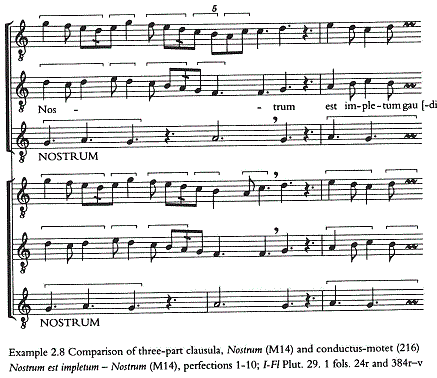 �@These examples outline the more important ways in which the composers of motets set about adding texts to their melismatic originals. The musical foreground was, by and large, respected wherever possible. When the simple relationship between word and note became strained, however, the composers had no hesitation in modifying the clausulae, either for reasons of necessity, or for those of artistic choice. Under circumstances in which, as we shall see, new music was being written to add t�� the clausula, this is hardly surprising�B �@����������́A���e�b�g��҂��I���W�i���ȃ����X�}�ɑ��ĉ̎��Â������邽�߂̂��d�v�ȕ��@�������Ă���B���y�I�ȑO�i���\�Ȍ���A���d����Ă����B���t�Ɖ��̒P���ȊW���Ђ��݂�ттĂ���Ƃ������Ȃ���A��Ȏ҂����́A�K�v���̊ϓ_���炠�邢�͌|�p��̂��ꂩ��A�N���E�Y�����������邱�Ƃɂ��߂炤���Ƃ͂Ȃ������B�����������Ă����悤�ɁA�V�������y���N���E�Y���ɕt�^�����ꑱ���Ă��������ŁA����͂قƂ�Nj����ׂ����Ƃł͂Ȃ������B |